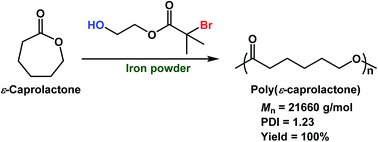A unique cooperative catalytic system carrying metallic iron and 2-hydroxyethyl 2-bromoisobutyrate for the controlled/living ring-opening polymerization of ε-caprolactone†
Abstract
We herein report an interesting cooperative catalytic system containing iron powder and 2-hydroxyethyl 2-bromoisobutyrate (HEBiB), which can efficiently catalyze the ring-opening polymerization of ε-caprolactone (CL) under facile conditions, forming poly(ε-caprolactone) (PCL) with appreciably high molecular weight (Mn), narrow molecular weight distribution and high yield. The 1H NMR and GPC (gel permeation chromatography) measurements of the resulting PCL clearly indicate the presence of the initiator residue at the chain end. Optimization reactions, wherein iron powder or HEBiB alone, the combinative use of iron powder and benzyl alcohol (BnOH), iron powder and alkyl bromides in the absence/presence of benzyl alcohol (BnOH) are introduced, reveal that iron and alkyl bromides collectively initiate the reaction and define the molecular weight of PCL, while the presence of the hydroxyl group leads to higher product yields. The effects of metal contaminants, hydroxyl initiators, solvents, reaction temperatures and reaction times are also investigated. The kinetic and chain extension experiments support the controlled/living nature of the HEBiB/Fe-catalyzed ROP of CL.


 Please wait while we load your content...
Please wait while we load your content...